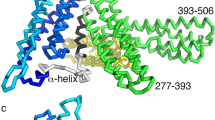Abstract
E-cadherin is a transmembrane glycoprotein which is involved in the Ca2+-dependent cell–cell adhesion, and the adhesiveness is heavily dependent on the homodimerization of this molecule. Previous studies have shown that both the extracellular domain and cytoplasmic domain of E-cadherin contribute to its homodimerization. However, the roles of the transmembrane(TM) domain in the E-cadherin homodimerization have not been discussed in detail. In our experiments, SDS-PAGE showed higher molecular weight bands for the synthetic E-cadherin TM peptide, which indicated that the E-cadherin TM peptide is able to dimerize in the SDS micelle. The TOXCAT assay proved that the E-cadherin TM domain can form a moderate homo-oligomer in the Escherichia coli inner membrane. Furthermore, mutational analyses using the TOXCAT assays revealed that, instead of the common GxxxG dimerization motif, the leucine zipper motif is essential for the dimerization of the E-cadherin TM domain. Combining our experiment data and the computational simulation results, we provide insights for understanding the roles of the TM domain in the E-cadherin dimerization.





Similar content being viewed by others
References
Berger O, Edholm O, Jahnig F (1997) Molecular dynamics simulations of a fluid bilayer of dipalmitoylphosphatidylcholine at full hydration, constant pressure, and constant temperature. Biophys J 72(5):2002–2013
Boggon TJ, Murray J, Chappuis-Flament S, Wong E, Gumbiner BM, Shapiro L (2002) C-cadherin ectodomain structure and implications for cell adhesion mechanisms. Science 296(5571):1308–1313
Cheung R, Espenshade PJ (2013) Structural requirements for sterol regulatory element-binding protein (SREBP) cleavage in fission yeast. J Biol Chem 288:20351–20360
DeLano WL (2002) The PyMOL molecular graphics system. DeLano Scientific, Palo Alto
Dell’Orco D, De Benedetti PG, Fanelli F (2007) In silico screening of mutational effects on transmembrane helix dimerization: insights from rigid-body docking and molecular dynamics simulations. J Phys Chem 111(30):9114–9124
Gumbiner BM (2005) Regulation of cadherin-mediated adhesion in morphogenesis. Nat Rev Mol Cell Biol 6:622–634
Huber O, Kemler R, Langosch D (1999) Mutations affecting transmembrane segment interactions impair adhesiveness of E-cadherin. J Cell Sci 112(Pt23):4415–4423
Lemmon MA, Engelman DM (1994) Specificity and promiscuity in membrane helix interactions. FEBS Lett 346(1):17–20
Li R, Gorelik R, Nanda V, Law PB, Lear JD, DeGrado WF, Bennett JS (2004) Dimerization of the transmembrane domain of integrin alphaIIb subunit in cell membranes. J Biol Chem 279(25):26666–26673
MacKenzie KR, Prestegard JH, Engelman DM (1997) A transmembrane helix dimer: structure and implications. Science 276:131–133
Makagiansar IT, Nguyen PD, Ikesue A, Kuczera K, Dentler W, Urbauer JL, Galeva N, Alterman M, Siahaan TJ (2002) Disulfide bond formation promotes the cis- and trans-dimerization of the E-cadherin-derived first repeat. J Biol Chem 277(18):16002–16010
Melnyk RA, Partridge AW, Deber CM (2002) Transmembrane segment dimerization of the major coat protein from Ff bacteriophage. J Mol Biol 315:63–72
Melnyk RA, Partridge AW, Yip J, Wu Y, Goto NK, Deber CM (2003) Polar residue tagging of transmembrane peptides. Biopolymers 71(6):675–685
Nose A, Tsuji K, Takeichi M (1990) Localization of specificity determining sites in cadherin cell adhesion molecules. Cell 61(1):147–155
Overduin M, Harvey TS, Bagby S, Tong KI, Yau P, Takeichi M, Ikura M (1995) Solution structure of the epithelial cadherin domain responsible for selective cell adhesion. Science 267(5196):386–389
Ozawa M (2002) Lateral dimerization of the E-cadherin extracellular domain is necessary but not sufficient for adhesive activity. J Biol Chem 277(22):19600–19608
Ozawa M, Kemler R (1998) The membrane-proximal region of the E-cadherin cytoplasmic domain prevents dimerization and negatively regulates adhesion activity. J Cell Biol 142(6):1605–1613
Pece S, Gutkind JS (2002) E-cadherin and Hakai: signalling, remodeling or destruction? Nat Cell Biol 4:E72–E74
Plotkowski ML, Kim S, Phillips ML, Partridge AW, Deber CM, Bowie JU (2007a) The transmembrane domain of myelin protein zero can form dimers: possible implications for myelin construction. Biochemistry 46:12164–12173
Plotkowski ML, Kim S, Phillips ML, Partridge AW, Deber CM, Bowie JU (2007b) Transmembrane domain of myelin protein zero can form dimers: possible implications for myelin construction. Biochemistry 46(43):12164–12173
Russ WP, Engelman DM (1999) TOXCAT: a measure of transmembrane helix association in a biological membrane. Proc Natl Acad Sci USA 96(3):863–868
Ryan L, Lamarre B, Diu T, Ravi J, Judge PJ, Temple A, Carr M, Cerasoli E, Su B, Jenkinson HF, Martyna G, Crain J, Watts A, Ryadnov MG (2013) Anti-antimicrobial peptides: folding-mediated host defense antagonists. J Biol Chem 288:20162–20172
Shapiro L, Fannon AF, Kwong PD, Thompson A, Lehmann MS, Grubel G, Legrand JF, Als-Nielsen J, Colman DR, Hendrickson WA (1994) Structural basis of cell–cell adhesion by cadherins. Nature 374:327–337
Tieleman DP, Berendsen HJC, Sansom MSP (1999) An alamethicin channel in a lipid bilayer: molecular dynamics simulations. Biophys J 76(4):1757–1769
Troyanovsky RB, Sokolov E, Troyanovsky SM (2003) Adhesive and lateral E-cadherin dimers are mediated by the same interface. Mol Cell Biol 23(22):7965–7972
van Gunsteren WF, Billeter SR, Eising AA, Hunenberger PH, Kruger P, Mark AE, Scott WRP, Tironi IG (1996) Biomolecular simulation: the GROMOS96 manual and user guide. Vdf Hochschulverlag AG an der ETH Zurich, Zurich
von Heijne G (1991) Proline kinks in transmembrane alpha-helices. J Mol Biol 218(3):499–503
Yap AS, Niessen CM, Gumbiner BM (1998) The juxtamembrane region of the cadherin cytoplasmic tail supports lateral clustering, adhesive strengthening, and interaction with p120ctn. J Cell Biol 141(3):779–789
Acknowledgements
This work was supported by the National Basic Research Program of China (973 program) (2013CB910700) and the National Natural Science Foundation of China (No. 20932003, No. 21002007), and Beijing NOVA Programme (xx2013010).
Conflict of interest
We declare that we have no conflict of interest. No patients and animals are involved.
Author information
Authors and Affiliations
Corresponding author
Additional information
Lida Xu and Ting-Ting Hu have contributed equally to this study.
Rights and permissions
About this article
Cite this article
Xu, L., Hu, TT. & Luo, SZ. Leucine Zipper Motif Drives the Transmembrane Domain Dimerization of E-cadherin. Int J Pept Res Ther 20, 95–102 (2014). https://doi.org/10.1007/s10989-013-9371-y
Accepted:
Published:
Issue Date:
DOI: https://doi.org/10.1007/s10989-013-9371-y



